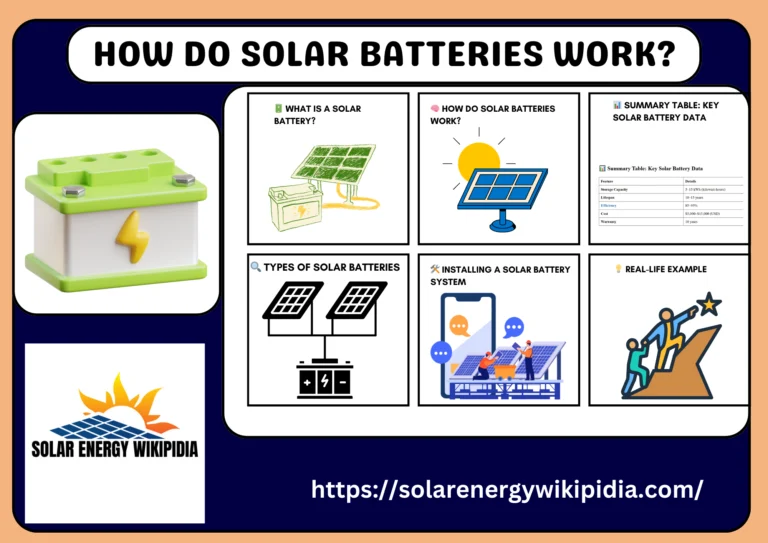
If Solar Batteries are essential to power your home. Explore how solar batteries can enhance energy efficiency and reduce your electricity bills.
Making the switch to solar energy represents more than just a trend – it is a revolutionary step toward reducing electricity costs and gaining true energy independence. As solar technology becomes more accessible, homeowners are increasingly asking one critical question: How many solar batteries do I actually need to power my entire house?
This comprehensive guide breaks down everything you need to understand about solar battery requirements, storage capacity calculations, and determining your specific home energy needs. Whether you are considering a backup system during outages or planning to go completely off-grid, this article provides the essential knowledge to make informed decisions about your solar battery investment.
Table of Contents
1. Solar Battery Fundamentals: What You Need to Know First

Solar batteries serve as the energy bank for your solar power system. They store excess electricity generated by your solar panels during sunny periods, making that power available when you need it most – during nighttime hours, cloudy days, or grid outages. The number of batteries required for your specific situation depends on several crucial factors that must be carefully considered.
Critical Factors Determining Your Solar Battery Requirements:
- Daily Energy Consumption: The total electricity your household uses each day (measured in kilowatt-hours or kWh)
- Battery Storage Capacity: How much energy each battery can hold (kWh per battery)
- Available Sunlight: The average number of sunlight hours in your specific location
- System Efficiency: The combined efficiency rating of your solar panels and battery storage system
- Connection Type: Whether you’re planning a grid-connected system with net metering or a fully off-grid setup
- Usage Patterns: Which appliances you run and when you typically use the most electricity
- Seasonal Variations: How your energy demands change throughout different seasons
- Emergency Backup Needs: How long you want to maintain power during extended outages
Understanding these variables is essential before calculating the exact number of batteries your home requires. Each factor plays a significant role in designing an optimal system that meets your energy needs without unnecessary expense.
2. Exploring Your Solar Battery Options: 5 Types Compared

The market offers various solar battery technologies, each with distinct advantages and limitations that affect performance, lifespan, and cost. Understanding these differences is crucial for selecting the right battery type for your specific needs.
1. Lithium-Ion Batteries
Advantages:
- 90-95% energy efficiency rating – among the highest available
- Exceptional depth of discharge (DoD) often exceeding 90%
- Compact design requiring minimal space
- 10-15 year lifespan with 6,000+ charge cycles
- Minimal maintenance requirements
- Rapid charging capabilities
Limitations:
- Higher upfront investment ($9,000-$15,000 installed)
- Performance gradually decreases in extreme temperatures
- Environmental concerns regarding mining and disposal
Best For: Homeowners seeking long-term reliability and maximum efficiency who can afford the initial investment.
2. Lead-Acid Batteries
Advantages:
- 50-60% lower initial cost than lithium-ion
- Established technology with proven reliability
- Widely available replacement parts
- Excellent surge power capabilities
Limitations:
- Limited 50-60% depth of discharge (DoD)
- Shorter lifespan (3-5 years with proper maintenance)
- Requires regular maintenance and ventilation
- Larger physical footprint
- 70-80% efficiency rating
Best For: Budget-conscious homeowners with sufficient installation space who can perform regular maintenance.
3. Saltwater (Sodium-Ion) Batteries
Advantages:
- 100% recyclable and environmentally friendly
- Non-toxic materials without heavy metals
- No risk of thermal runaway (fire safety)
- Moderate lifespan of 5,000+ cycles
Limitations:
- Lower energy density requiring more space
- Limited availability compared to mainstream options
- Mid-range efficiency (80-85%)
- Emerging technology with fewer established manufacturers
Best For: Environmentally conscious homeowners prioritizing sustainability over maximum performance.
4. Flow Batteries
Advantages:
- Exceptional longevity (20+ years possible)
- Nearly unlimited cycle life
- Easily scalable for large storage capacity
- 100% depth of discharge without degradation
Limitations:
- Significantly higher upfront costs
- Complex system requiring professional maintenance
- Larger installation footprint
- Less efficient than lithium-ion (70-80%)
Best For: Large properties requiring substantial storage capacity with long-term investment perspective.
5. Nickel-Cadmium (Ni-Cd) Batteries
Advantages:
- Extremely durable in harsh weather conditions
- Reliable performance in wide temperature ranges
- Long cycle life without significant maintenance
- Can withstand complete discharge without damage
Limitations:
- Contains toxic cadmium requiring special disposal
- Lower energy density than modern alternatives
- Subject to “memory effect” reducing capacity over time
- Moderate efficiency (65-80%)
Best For: Installations in extreme environments where temperature resilience is critical.
3. Calculating Your Solar Battery Requirements: 6-Step Process

Determining the precise number of batteries your home needs involves a systematic approach. Follow these six essential steps to accurately size your solar battery system:
Step 1: Calculate Your Home’s Daily Energy Consumption
The foundation of proper battery sizing begins with understanding your specific energy usage. Review your electricity bills from the past 12 months to identify both average and peak consumption periods.
Quick Calculation Method:
- Locate your monthly kWh usage on your electricity bill
- Divide by 30 to determine daily usage
- The average American home consumes approximately 30 kWh daily (900 kWh monthly)
Detailed Assessment Method:
- Create an inventory of all electrical appliances
- Note the wattage of each device and estimated daily usage hours
- Multiply watts × hours used ÷ 1000 to calculate kWh per device
- Sum all device calculations for total daily consumption
Pro Tip: Energy monitoring devices like Sense or Emporia can provide real-time usage data for more accurate calculations.
Step 2: Determine Critical Load Requirements
Not all home electrical devices are equally important during power outages. Creating a “critical load” list helps prioritize essential equipment when designing battery backup systems.
Common Critical Loads:
- Refrigeration and freezer (1-2 kWh daily)
- Water pump systems (0.5-1 kWh daily)
- Heating/cooling equipment (varies significantly by climate)
- Medical devices (varies based on equipment)
- Lighting (0.5-1 kWh daily for LED lighting)
- Communication devices and internet equipment (0.2-0.5 kWh daily)
Step 3: Select Battery Capacity and Type
Battery capacity is measured in kilowatt-hours (kWh), representing the total energy a battery can store. Modern residential solar batteries typically offer capacities between 5-15 kWh per unit.
Popular Battery Capacities:
- Tesla Powerwall: 13.5 kWh usable capacity
- LG Chem RESU: Models range from 9.3 kWh to 16 kWh
- Enphase IQ Battery: Modular system with 3.36 kWh per unit
- Generac PWRcell: Scalable from 9 kWh to 36 kWh
Step 4: Account for Depth of Discharge (DoD)
Most batteries should not be discharged completely to maintain longevity. The usable capacity is determined by the battery’s depth of discharge rating.
Calculation Example: For a 10 kWh battery with 90% DoD:
- Usable capacity = 10 kWh × 0.9 = 9 kWh
Step 5: Calculate Required Battery Quantity
Use this formula to determine how many batteries you need:
Copy
Number of Batteries = (Daily Energy Usage ÷ (Battery Capacity × DoD × Efficiency))
Example Calculation: For a home using 30 kWh daily with 10 kWh batteries at 90% DoD and 95% efficiency:
- Number of Batteries = 30 ÷ (10 × 0.9 × 0.95) = 30 ÷ 8.55 = 3.51 batteries
This calculation indicates you would need at least 4 batteries to fully power your home.
Step 6: Include Safety Margin and Future Expansion
Energy experts recommend adding a 20-30% capacity buffer to account for:
- Unexpected usage spikes
- Extended periods of limited sunlight
- Battery degradation over time
- Potential future increases in electricity consumption
Final Calculation:
- 4 batteries × 1.25 (25% buffer) = 5 batteries recommended
4. Grid-Tied vs. Off-Grid Systems: Making the Right Choice
Your connection strategy significantly impacts battery requirements. Understanding the differences between staying connected to the utility grid versus complete independence helps determine the optimal approach for your situation.
Grid-Tied Systems with Battery Backup
Key Characteristics:
- Maintains connection to utility power grid
- Uses net metering to exchange electricity with the grid
- Requires fewer batteries – primarily for backup during outages
- Lower overall system cost
- Provides energy security without complete independence
Typical Battery Requirements:
- Backing up critical loads only: 1-2 batteries
- Whole-home backup (8-12 hours): 2-4 batteries
- Extended backup capabilities: 4-6 batteries
Financial Considerations:
- Investment range: $12,000-$25,000 including installation
- Potential utility incentives and net metering benefits
- Federal tax credits (currently 30% of system cost)
- ROI period: 7-10 years depending on utility rates
Off-Grid Systems (Complete Energy Independence)
Key Characteristics:
- No connection to utility grid
- Requires substantial battery capacity
- Often includes generator backup for extended low-sun periods
- Higher initial investment
- Total energy independence and elimination of utility bills
Typical Battery Requirements:
- Minimum requirement: 4-8 batteries depending on consumption
- Comfortable capacity: 8-12 batteries for average homes
- Luxury capacity: 12+ batteries for larger homes with higher consumption
Financial Considerations:
- Investment range: $30,000-$60,000+ including installation
- Higher maintenance costs over system lifetime
- No utility connection fees or monthly bills
- ROI period: 10-15 years depending on previous utility costs
Expert Recommendation: Most homeowners benefit most from grid-tied systems with battery backup, achieving energy security while maintaining grid connection for reliability and cost-effectiveness.
5. Installation, Maintenance, and System Optimization: 7 Essential Practices

Proper installation and ongoing maintenance significantly extend battery life and optimize system performance. Follow these seven best practices:
1. Professional Installation
Always hire certified solar professionals for installation to ensure:
- Proper electrical connections and safety compliance
- Optimal battery placement considering temperature control
- Integration with existing electrical systems
- Proper permitting and utility interconnection (for grid-tied systems)
- Warranty protection and performance guarantees
2. Temperature Management
Battery performance is heavily influenced by ambient temperature:
- Maintain installation environment between 50-85°F (10-29°C)
- Install in climate-controlled spaces when possible
- Consider insulated battery enclosures for extreme climates
- Monitor temperature regularly through battery management systems
3. Cycle Management
Proper charging and discharging patterns extend battery life:
- Avoid frequent deep discharges below recommended DoD
- Implement smart energy management systems to optimize cycles
- Program charge controllers to manufacturer specifications
- Consider time-of-use optimization for grid-tied systems
4. Regular Monitoring
Implement comprehensive monitoring solutions:
- Install battery management systems (BMS) to track performance
- Monitor individual cell voltages when possible
- Track efficiency and capacity changes over time
- Set up automated alerts for abnormal conditions
5. Preventative Maintenance
Schedule regular maintenance checks:
- Inspect connections for corrosion quarterly
- Clean ventilation systems and heat sinks
- Verify proper system operation after extreme weather events
- Update firmware and management software when available
6. System Integration
Maximize efficiency through integrated design:
- Pair batteries with appropriately sized solar arrays
- Implement energy management systems to prioritize loads
- Consider load-shifting strategies to optimize battery usage
- Integrate smart home technology for automated energy optimization
7. Emergency Preparedness
Develop protocols for extended outages:
- Create prioritized load-shedding plans
- Establish backup charging options (generators, etc.)
- Document emergency procedures for system management
- Maintain essential spare parts for critical components
6. Top 7 Solar Batteries for Home Power Systems (2025 Edition)
The solar battery market continues evolving with new innovations. Here are the top seven options currently available, ranked by overall value and performance:
| Battery System | Usable Capacity | DoD | Cycle Life | Warranty | Price Range | Key Advantage |
| Tesla Powerwall 2 | 13.5 kWh | 100% | 7,000+ cycles | 10 years | $11,000-$12,500 | Integrated inverter & best mobile app |
| LG Chem RESU Prime | 16 kWh | 95% | 6,000 cycles | 10 years | $9,000-$11,000 | Excellent temperature performance |
| Enphase IQ Battery 10T | 10.1 kWh | 96% | 4,000 cycles | 10 years | $8,500-$10,000 | Microinverter compatibility |
| Generac PWRcell | 9-18 kWh (modular) | 84% | 6,500 cycles | 10 years | $9,500-$18,000 | Scalable design |
| Sonnen eco | 5-20 kWh (modular) | 100% | 10,000 cycles | 15 years | $10,000-$22,000 | Longest warranty & lifespan |
| BYD Battery-Box Premium | 5.1-22.1 kWh (modular) | 95% | 8,000 cycles | 10 years | $7,500-$16,000 | Most cost-effective scaling |
| FranklinWH aPower | 13.6 kWh | 100% | 6,000 cycles | 12 years | $9,800-$11,500 | Advanced AI energy management |
Expert Recommendation: For most homeowners, the Tesla Powerwall 2 offers the best combination of capacity, performance, and user experience, while the BYD Battery-Box provides excellent value for those building larger systems.
7. Real-World Performance: Case Studies of Home Battery Systems
Understanding how different battery configurations perform in actual homes provides valuable insights for your planning process.
Case Study 1: Suburban Home with Grid-Tied System
- Home Size: 2,500 sq ft, 4 bedrooms
- Location: Colorado
- Daily Usage: 28 kWh average
- System Configuration: 10kW solar array with 2 Tesla Powerwalls (27 kWh total)
- Performance Results:
- 92% energy self-sufficiency annually
- Complete backup power during three grid outages
- ROI tracking for 7-year payback period
- $2,800 annual utility savings
Case Study 2: Rural Off-Grid Homestead
- Home Size: 1,800 sq ft, 3 bedrooms
- Location: Arizona
- Daily Usage: 18 kWh average
- System Configuration: 12kW solar array with 8 LG Chem batteries (78.4 kWh total)
- Performance Results:
- 100% energy independence year-round
- 3 days autonomy during cloudy periods
- Small generator required only 5 days annually
- Complete elimination of $3,600 annual utility costs
Case Study 3: Urban Apartment Building Community Solar
- Building Size: 12 units
- Location: California
- Daily Usage: 180 kWh combined
- System Configuration: 30kW shared solar array with 15 Enphase batteries (150 kWh total)
- Performance Results:
- 78% reduction in building energy costs
- Time-of-use optimization saving additional 15%
- Resilience during rolling blackouts
- 9-year projected ROI for building owner
Final Thought
The number of solar batteries required to power your home depends on multiple interconnected factors, most importantly your energy consumption patterns, desired level of independence, and budget constraints. For grid-tied systems seeking backup capabilities, 2-4 batteries typically provide sufficient coverage for essential needs. Off-grid homes generally require 6-10 batteries for complete energy independence.
By thoroughly analyzing your specific energy requirements, selecting appropriate battery technology, and working with qualified installation professionals, you can design a solar battery system that provides reliable power, significant cost savings, and valuable energy independence. The initial investment in quality battery storage continues to deliver returns through lower electricity costs, increased energy security, and reduced environmental impact for decades to come.
Whether you’re taking your first step toward energy independence or expanding an existing solar system, proper battery sizing ensures you maximize the benefits of renewable energy storage for your specific situation.







